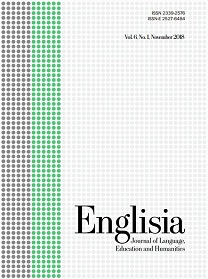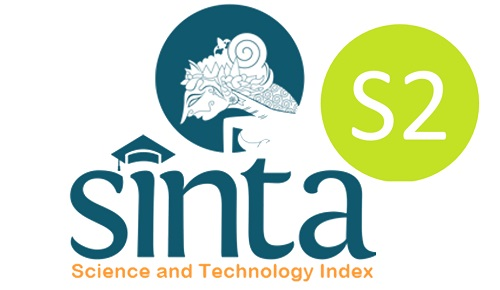A critical discourse analysis of Bintang Emon’s humor discourse entitled ‘Ga Sengaja’
DOI:
https://doi.org/10.22373/ej.v8i2.8461Keywords:
Critical Discourse Analysis, humor discourse, criticismAbstract
This study aims to investigate the text, the discourse practice, and the sociocultural practice of Bintang Emon’s discourse humor video entitled “Accidentally (Ga Sengaja),” posted on his Instagram platform. To analyze the data, the qualitative descriptive method was used in this study. The data were obtained from the video transcript of Bintang Emon accessed from Instagram. The data were then analyzed by using Norman Fairclough’s discourse analysis model. Moreover, the techniques used were observing, interpreting the data by analyzing the text, which was seen from three elements such as Representation, Relation, and Identity; analyzing the discourse practice which focused on production, consumption, reproduction of the text; and analyzing the socio-cultural practice of the discourse humor, and the last is concluding. The result of this study showed that Bintang Emon used more rhetorical figures in his discourse in the analysis of text level. He delivered his criticism with good word choices and conveyed some analogies to make the audiences agree with what he said. The intention of his complaint regarding Novel Baswedan’s acid attack case was expressed implicitly so that the audiences cannot predict his intention if they only look at it from his caption. In the level of discourse practice, he successfully represented most of the citizens’ criticism against the case. Furthermore, he took his right to freedom of speech to deliver his thought in a humorous style.
Downloads
References
Aarons, D., & Mierowsky, M. (2017). How to Do Things with Jokes: Speech Acts in Standup Comedy Title. European Journal of Humor Research, 5(4), 158–168.
Attardo, S., Attardo, D. H., Baltes, P., & Petray, M. J. (1994). The linear organization of jokes: Analysis of two thousand texts. Humor: International Journal of Humor Research, 7(1), 27–54.
Bucaria, C. (2004). Lexical and Syntactic Ambiguity as a Source of Humor: The Case of Newspaper Headlines. Humor-International Journal of Humor Research, 17(3), 279–309.
Fairclough, N. (2001). Critical discourse analysis as a method in social scientific research. In R. Wodak & M. Meyer (Eds.), Methods of Critical Discourse Analysis (pp. 121–138). Sage.
Fairclough, N. (2005). Analyzing Discourse. Textual Analysis for Social Research. Routledge.
Fairclough, N. L. (1985). Critical and descriptive goals in discourse analysis. Journal of Pragmatics, 9(6), 739–763. https://doi.org/10.1016/0378-2166(85)90002-5
Fairclough, N. (1989). Language and Power. Longman Inc.
Fairclough, N. (1995). Media Discourse. Edward Arnold.
Fairclough, N. (2003). Analysing Discourse: Textual Analysis for Social Research. Taylor & Francis Routledge.
Fairclough, N. (2012). Critical discourse analysis. In J. P. J. P. Gee & M. Handford (Eds.), The Routledge handbook of discourse analysis (pp. 9–21). Routledge.
Fairclough, Norman. (2010). Critical Discourse Analysis- The Critical Study of Language (2nd edition). Longman.
Haynes, N. (2019). Writing on the Walls: Discourses on Bolivian Immigrants in Chilean Meme Humor. International Journal of Communication, 13, 3122–3142.
Kholidah, N. N., Widodo, S. T., & Saddhono, K. (2020). Traditional Stage as a Medium of Social Criticism: the Role of Humor in Ludruk Performance Art. Journal of Critical Reviews, 7(7), 1–5.
Latupeirissa, D. S., Laksana, I. K. D., Artawa, K., & Sosiowati, I. G. A. G. (2019). On Political Language Ideology: Critical View of Indonesian President Speech. Journal of Language Teaching and Research, 10(4), 843–850.
Leonardo, R., & Junaidi, A. (2020). Kritik Sosial dalam Stand Up Comedy (Analisis Semiotika Show “Pragiwaksono World Tour”). Koneksi, 4(2), 185–190.
Mohammadi, M. (2017). A Critical Discourse Analysis of Donald Trump’s Language Use in US Presidential Campaign. International Journal of Applied Linguistics & English Literature, 6(5), 1–10. https://doi.org/doi:10.7575/aiac.ijalel.v.6n.5p.1
Nilsen, D. L. F., & Nilsen, A. P. (2019). The Language of Humor: An Introduction. Cambridge University Press.
Oaks, D. D. (1994). Humor. Walter de Gruyter, 7(4), 377–401.
Puksi, F. F. (2018). Presupposition Contributions in Stand-up Comedy: Discourse Analysis of Raditya Dika’s Stand-up Comedy on Youtube. Journal of Applied Studies in Language, 2(2), 135–143.
Risdianto, F., Sumarlam., & Malihah, N. (2018). The Representation of Power in the Text News on the Meiliana Case (A Norman Fairclough Critical Discourse Analysis). Advances in Social Sciences, Education and Humanities Research, 280(June 2019), 236.
Rogers, R. (2004). An Introduction to Critical Discourse Analysis in Education. Lawrence Erlbaum Associates, Inc.
Romansyah, T. S., Hidayat, D. N., Alek, & Setiono, D. P. (2020). A Critical Discourse Analysis of Dzawin’s Stand Up Comedy Humor. European Union Digital Library.
Sabir, M., & Kanwal, N. (2018). Norman fairclough’s Model as a Research Tool in the Critical Discourse Analysis of Rober Frost’s poem Fire and Ice. University of Wah Journal of Social Science and Humanities, 1(1), 83–99.
Savage, B. M., Lujan, H. L., Thipparthi, R. R., & DiCarlo, S. E. (2017). Humor, Laughter, Learning, and Health! A brief review. Advance Physiological Education, 41, 314–347.
Van Dijk, T. A. (2005). Critical discourse analysis. In E. Schriffin, D. Tannen, & H. E. Hamilton (Eds.), The Handbook of discourse analysis (pp. 352–371). Blackwell Publishers.
Wortley, A., & Dotson, E. (2016). Stand up comics: Instructional Humor and Student engagement. Journal of Instructional Research, 5, 13–18.
Yue, X. D., Leung, C.-L., & Hiranandani, N. A. (2016). Adult Playfulness, Humor Styles, and Subjective Happiness. Psychological Reports, 119(3), 630–640.
Zhu, L., & Wang, W. (2020). A Critical Discourse Analysis of the US and China Political Speeches—Based on the Two Speeches Respectively by Trump and Wang Yi in the General Debate of the 72nd Session of UN Assembly. Journal of Language Teaching and Research, 11(3), 435–445.
Downloads
Published
Issue
Section
License
Proposed Policy for Journals That Offer Open Access
Authors who publish with Englisia journal agree to the following terms:
- Authors retain copyright and grant the journal right of first publication with the work simultaneously licensed under a Creative Commons Attribution License that allows others to share the work with an acknowledgement of the work's authorship and initial publication in this journal.
- Authors are able to enter into separate, additional contractual arrangements for the non-exclusive distribution of the journal's published version of the work (e.g., post it to an institutional repository or publish it in a book), with an acknowledgement of its initial publication in this journal.
- Authors are permitted and encouraged to post their work online (e.g., in institutional repositories or on their website) prior to and during the submission process, as it can lead to productive exchanges, as well as earlier and greater citation of published work (See The Effect of Open Access).









